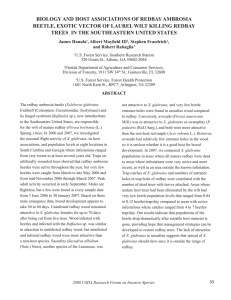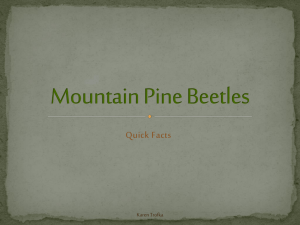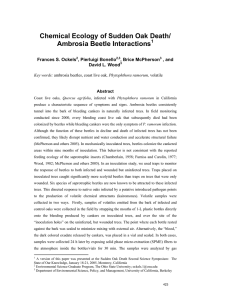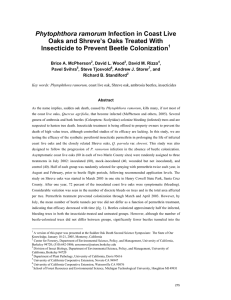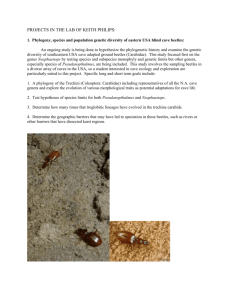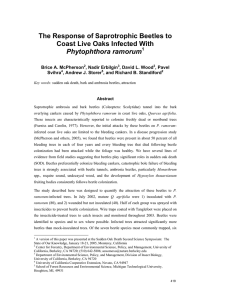Attraction of Ambrosia and Bark Beetles to Phytophthora
advertisement
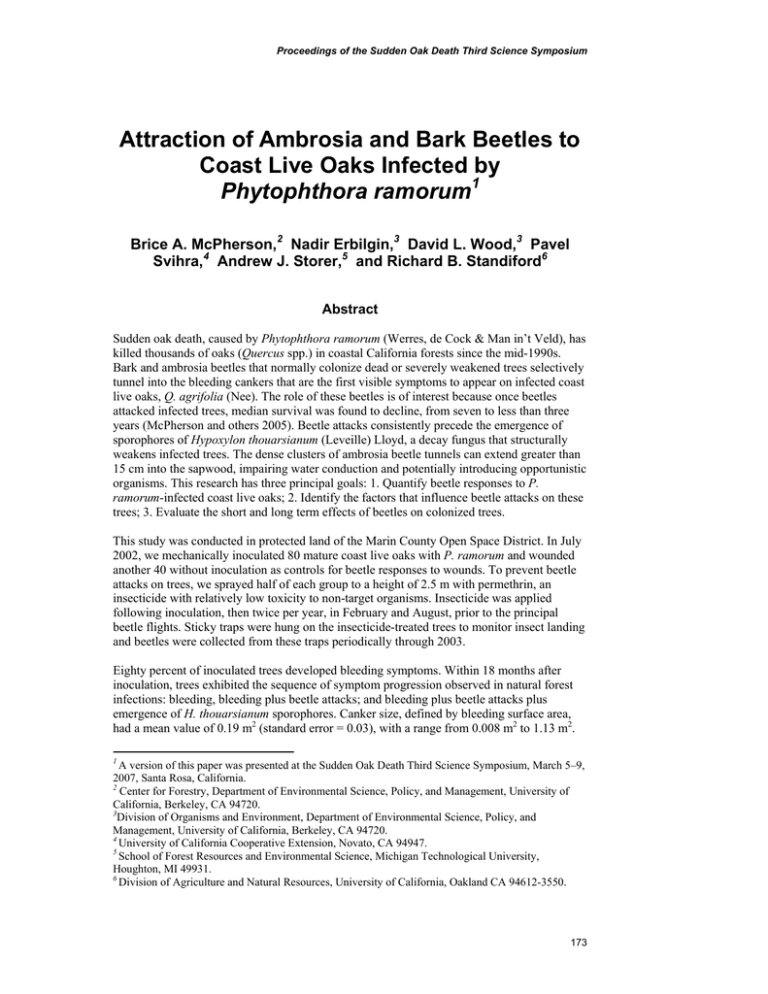
Proceedings of the Sudden Oak Death Third Science Symposium Attraction of Ambrosia and Bark Beetles to Coast Live Oaks Infected by Phytophthora ramorum1 Brice A. McPherson,2 Nadir Erbilgin,3 David L. Wood,3 Pavel Svihra,4 Andrew J. Storer,5 and Richard B. Standiford6 Abstract Sudden oak death, caused by Phytophthora ramorum (Werres, de Cock & Man in’t Veld), has killed thousands of oaks (Quercus spp.) in coastal California forests since the mid-1990s. Bark and ambrosia beetles that normally colonize dead or severely weakened trees selectively tunnel into the bleeding cankers that are the first visible symptoms to appear on infected coast live oaks, Q. agrifolia (Nee). The role of these beetles is of interest because once beetles attacked infected trees, median survival was found to decline, from seven to less than three years (McPherson and others 2005). Beetle attacks consistently precede the emergence of sporophores of Hypoxylon thouarsianum (Leveille) Lloyd, a decay fungus that structurally weakens infected trees. The dense clusters of ambrosia beetle tunnels can extend greater than 15 cm into the sapwood, impairing water conduction and potentially introducing opportunistic organisms. This research has three principal goals: 1. Quantify beetle responses to P. ramorum-infected coast live oaks; 2. Identify the factors that influence beetle attacks on these trees; 3. Evaluate the short and long term effects of beetles on colonized trees. This study was conducted in protected land of the Marin County Open Space District. In July 2002, we mechanically inoculated 80 mature coast live oaks with P. ramorum and wounded another 40 without inoculation as controls for beetle responses to wounds. To prevent beetle attacks on trees, we sprayed half of each group to a height of 2.5 m with permethrin, an insecticide with relatively low toxicity to non-target organisms. Insecticide was applied following inoculation, then twice per year, in February and August, prior to the principal beetle flights. Sticky traps were hung on the insecticide-treated trees to monitor insect landing and beetles were collected from these traps periodically through 2003. Eighty percent of inoculated trees developed bleeding symptoms. Within 18 months after inoculation, trees exhibited the sequence of symptom progression observed in natural forest infections: bleeding, bleeding plus beetle attacks; and bleeding plus beetle attacks plus emergence of H. thouarsianum sporophores. Canker size, defined by bleeding surface area, had a mean value of 0.19 m2 (standard error = 0.03), with a range from 0.008 m2 to 1.13 m2. 1 A version of this paper was presented at the Sudden Oak Death Third Science Symposium, March 5–9, 2007, Santa Rosa, California. 2 Center for Forestry, Department of Environmental Science, Policy, and Management, University of California, Berkeley, CA 94720. 3 Division of Organisms and Environment, Department of Environmental Science, Policy, and Management, University of California, Berkeley, CA 94720. 4 University of California Cooperative Extension, Novato, CA 94947. 5 School of Forest Resources and Environmental Science, Michigan Technological University, Houghton, MI 49931. 6 Division of Agriculture and Natural Resources, University of California, Oakland CA 94612-3550. 173 GENERAL TECHNICAL REPORT PSW-GTR-214 Although beetle attacks were not completely prevented by the permethrin treatment, beetle attacks on sprayed trees were delayed by about two months, compared with the unsprayed inoculated trees. The delay resulted in significantly fewer attacks throughout the year on the sprayed trees (repeated measures ANOVA, F1, 53 = 6.2, P = 0.016). The two principal variables that were found to significantly influence the responses of beetles to infected trees were the surface area covered by bleeding cankers and the numbers of beetles attacking these infected trees. Canker size measured in April 2003, before beetles had attacked any of the permethrin-treated trees, was a significant predictor of (log-transformed) trap catch for the year (F1,23 = 7.06, P = 0.014). By May, after the effectiveness of the insecticide declined, the number of beetle attacks per tree was the only variable that significantly affected trap catch for the year (repeated measures ANOVA, F1,21 = 32.63, P < 0.0001). Total trap catch for 2003 was 2,770 beetles, >95% of which were trapped on the inoculated trees. All species showed preference for infected trees. The principal beetle species trapped were (in order of decreasing abundance) Monarthrum scutellare (LeConte), Xyleborinus saxeseni (Ratzeburg), Pseudopityophthorus pubipennis (LeConte), M. dentigerum (LeConte), Scobicia declivis (LeConte), Xyleborus californicus (Wood), and Gnathotrichus pilosus (LeConte). Most of these species are sapwood-colonizing ambrosia beetles that are typically associated with recently killed hardwoods. Three of these saprotrophic ambrosia beetles are North American, and both X. saxeseni and X. californicus are Asian introductions. The oak bark beetle, P. pubipennis, feeds primarily in dead oaks and the lead cable borer, S. declivis, is a generalist beetle that tunnels into both hardwoods and softwoods. The number of beetles trapped on inoculated trees in 2003 was strongly correlated with advanced disease stage (trees that were attacked by beetles and those that also showed H. thouarsianum sporophores) through December 2006 (ordinal logistic regression, χ12 = 28.56, P < 0.001). Despite the transience of the permethrin treatment, the effects of preventing the first beetle attacks for two months have persisted for more than three years. The lower number of beetle attacks on the trees that were treated with insecticide was correlated with lower mortality. By December 2006, three of the permethrin-treated trees had died, compared with nine unsprayed trees. The 12 trees that died had all been extensively colonized by beetles and all but one had H. thouarsianum sporophores in the areas where beetles attacked early in 2003. The relationship between canker surface area and trap catch prior to beetle attacks is probably due to beetles responding to the production of volatile host- and/or host/pathogen-derived attractant compounds. Greater trap catch in 2003 was positively correlated with advanced disease status more than three years later, which suggests that the attraction of beetles to bleeding trees, as detected by trap catch, predicted the intensity of beetle attacks, and subsequently, the expression of disease in the trees. Further support for the role of volatile cues in the beetle response comes from the observation that beetles attacked some of the inoculated trees three months after they were inoculated, which was four months before the appearance of bleeding confirmed that they were infected. Once beetles had begun attacking the insecticide-treated trees, their production of aggregation and sex pheromones (for example, Wood 1982; Paine and others 1997) was probably the principal behavioral cue attracting additional beetles to infected trees. This work provides strong support for the hypothesis that beetles that tunnel deeply into the xylem of coast live oaks infected by P. ramorum accelerate disease progression and contribute to bole failure of living trees (Svihra and Kelly 2004). Where individual coast live oaks may be capable of limiting the expansion of cankers, beetle attacks on these cankers may irreversibly change the course of the disease. Tunnels provide entry for decay fungi, as well as pathogens, that are otherwise excluded from access to the sapwood resource. Research into 174 Proceedings of the Sudden Oak Death Third Science Symposium the relative importance of fungi and beetles in P. ramorum infection of coast live oaks is ongoing. Key words: Phytophthora ramorum, Quercus agrifolia, permethrin. Acknowledgments We wish to thank Dr. David Rizzo for providing P. ramorum cultures and Dr. Donald Bright for identifying the beetles. The field and laboratory assistance of Gabriela Ritokova and Andrew Nelson were critical. The United States Department of Agriculture-Forest Service, Pacific Southwest Research Station, provided funding for this study through grant number 02-CA-11272138-060. Marin County Open Space District provided access to research sites. Literature Cited McPherson, B.A.; Mori, S.R.; Wood, D.L.; Storer, A.J.; Svihra, P.; Kelly, N.M.; Standiford, R.B. 2005. Sudden oak death in California: disease progression in oaks and tanoaks. Forest Ecology and Management. 213: 71–89. Paine, T.D.; Raffa, K.F.; Harrington, T.C. 1997. Interactions among scolytid bark beetles, their associated fungi, and live host conifers. Annual Review of Entomology. 42: 179–206. Svihra, P.; Kelly, N.M. 2004. Importance of oak ambrosia beetles in predisposing coast live oak trees to wood decay. Journal of Arboriculture. 30: 371–375. Wood, D.L. 1982. The role of pheromones, kairomones, and allomones in the host selection and colonization behavior of bark beetles. Annual Review of Entomology. 27: 411–446. 175
